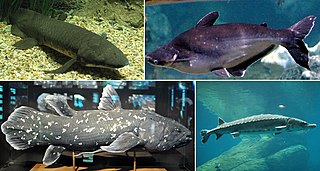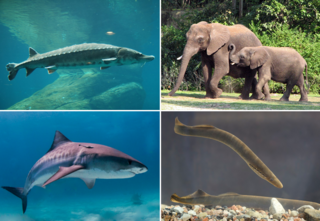
Actinopterygii, members of which are known as ray-finned fish or actinopterygians, is a class of bony fish that comprise over 50% of living vertebrate species. They are so called because of their lightly built fins made of webbings of skin supported by radially extended thin bony spines called lepidotrichia, as opposed to the bulkier, fleshy lobed fins of the sister class Sarcopterygii. Resembling folding fans, the actinopterygian fins can easily change shape and wetted area, providing superior thrust-to-weight ratios per movement compared to sarcopterygian and chondrichthyian fins. The fin rays attach directly to the proximal or basal skeletal elements, the radials, which represent the articulation between these fins and the internal skeleton.

Osteichthyes, also known as osteichthyans or commonly referred to as the bony fish, is a diverse superclass of vertebrate animals that have endoskeletons primarily composed of bone tissue. They can be contrasted with the Chondrichthyes and the extinct placoderms and acanthodians, which have endoskeletons primarily composed of cartilage. The vast majority of extant fish are members of Osteichthyes, being an extremely diverse and abundant group consisting of 45 orders, over 435 families and 28,000 species. It is the largest class of vertebrates in existence today, encompassing most aquatic vertebrates, as well as all semi-aquatic and terrestrial vertebrates.

Vertebrates are animals with a vertebral column, and a cranium, or skull. The vertebral column surrounds and protects the spinal cord, while the cranium protects the brain.

Salmon is the common name for several commercially important species of euryhaline ray-finned fish from the genera Salmo and Oncorhynchus of the family Salmonidae, native to tributaries of the North Atlantic (Salmo) and North Pacific (Oncorhynchus) basins. Other closely related fish in the same family include trout, char, grayling, whitefish, lenok and taimen, all coldwater fish of the subarctic and cooler temperate regions with some sporadic endorheic populations in Central Asia.

Fish and chips is a hot dish consisting of battered and fried fish, served with chips. Often considered the national dish of the United Kingdom, fish and chips originated in England in the 19th century. Today, the dish is a common takeaway food in numerous other countries, particularly English-speaking and Commonwealth nations.

Catfish are a diverse group of ray-finned fish. Named for their prominent barbels, which resemble a cat's whiskers, catfish range in size and behavior from the three largest species alive, the Mekong giant catfish from Southeast Asia, the wels catfish of Eurasia, and the piraíba of South America, to detritivores, and even to a tiny parasitic species commonly called the candiru, Vandellia cirrhosa. Neither the armour-plated types nor the naked types have scales. Despite their name, not all catfish have prominent barbels or "whiskers". Members of the Siluriformes order are defined by features of the skull and swimbladder. Catfish are of considerable commercial importance; many of the larger species are farmed or fished for food. Many of the smaller species, particularly the genus Corydoras, are important in the aquarium hobby. Many catfish are nocturnal, but others are crepuscular or diurnal.

Fish farming or pisciculture involves commercial breeding of fish, most often for food, in fish tanks or artificial enclosures such as fish ponds. It is a particular type of aquaculture, which is the controlled cultivation and harvesting of aquatic animals such as fish, crustaceans, molluscs and so on, in natural or pseudo-natural environments. A facility that releases juvenile fish into the wild for recreational fishing or to supplement a species' natural numbers is generally referred to as a fish hatchery. Worldwide, the most important fish species produced in fish farming are carp, catfish, salmon and tilapia.

Barbus is a genus of ray-finned fish in the family Cyprinidae. The type species of Barbus is the common barbel, first described as Cyprinus barbus and now named Barbus barbus. Barbus is the namesake genus of the subfamily Barbinae, but given their relationships, that taxon is better included in the Cyprininae at least for the largest part.

Pisces (♓︎) is the twelfth and final astrological sign in the zodiac. It is a mutable sign. It spans 330° to 360° of celestial longitude. Under the tropical zodiac, the sun transits this area between about February 19 and March 20. In classical interpretations, the symbol of the fish is derived from the ichthyocentaurs, who aided Aphrodite when she was born from the sea.

A fish is an aquatic, anamniotic, gill-bearing vertebrate animal with swimming fins and a hard skull, but lacking limbs with digits. Fish can be grouped into the more basal jawless fish and the more common jawed fish, the latter including all living cartilaginous and bony fish, as well as the extinct placoderms and acanthodians. In a break to the long tradition of grouping all fish into a single class (Pisces), contemporary phylogenetics views fish as a paraphyletic group.
The Congo barb is a species of ray-finned fish belonging to the family Cyprinidae, the family which includes the carps, barbs and related fishes. This species is found in the basin of the Congo River in the Democratic Republic of Congo; and in the Ruzizi River in Burundi and the Malagarasi River in western Tanzania in East Africa.
Clypeobarbus matthesi s a species of ray-finned fish belonging to the family Cyprinidae, the family which includes the carps, barbs and related fishes. This species is found in the basin of the Congo River.
Clypeobarbus is a genus of small cyprinid fishes native to Africa. Most species are restricted to the Congo River Basin, but C. pleuropholis is also found in the Chad Basin, while C. bellcrossi is from the Zambezi and C. hypsolepis is from rivers in Western Africa.
Clypeobarbus bomokandi is a species of ray-finned fish in the genus Clypeobarbus from the Congo Basin.
Clypeobarbus bellcrossi, the gorgeous barb, is a species of cyprinid fish native to Africa where it is found in the headwaters of the upper Zambezi River system. This species can reach a length of 9 centimetres (3.5 in) TL. It can also be found in the aquarium trade.
Clypeobarbus hypsolepis a species of ray-finned fish belonging to the family Cyprinidae, the family which includes the carps, barbs and related fishes. This species is found in West Africa where it is known from the Niger River and the upper basins of the Volta, Bandama and Agnéby River in Burkina Faso, Mali, Guinea, Ghana, Ivory Coast and Nigeria, with a disjunct population in the Niger Delta.
Clypeobarbus pseudognathodon is a species of ray-finned fish in the genus Clypeobarbus from central Africa where it is known from Lake Mweru, the Lobo River and the upper Lualaba River. Its max size is 5.5 centimeters.
Clypeobarbus schoutedeni is a species of cyprinid fish endemic to the Democratic Republic of the Congo where it is only known from the Dungu River. This species can reach a length of 3.8 centimetres (1.5 in) TL.

Pescetarianism is a dietary practice in which seafood is the only source of meat in an otherwise vegetarian diet. The inclusion of other animal products, such as eggs and dairy, is optional. According to research conducted from 2017 to 2018, approximately 3% of adults worldwide are pescetarian.
Smiliogastrinae is a subfamily of freshwater ray-finned fishes belonging to the famly Cyprinidae, the family which includes the carps, barbs and relalted fishes. The fishes in this genus are found in Africa and Asia and are commonly referred to as barbs.










